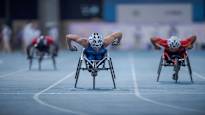Classification is an essential part of para sports. In this story, we go through the sports and classifications of the Finnish Paris Paralympic team.
Classification is an essential part of para sports, and it can be compared to weight class sports for the disabled. The goal of the classification is that the final result is decided by athletic factors, not by the severity of the injury.
There are ten different applicable disabilities in the classification, eight of which are physical disabilities. In addition to these, both visual impairment and developmental disability are included.
22 sports are contested at the Paris Summer Paralympics, and Finland is represented in six different sports. Each of these sports has its own classification, which is based on the athlete’s ability to function or, in the case of visually impaired athletes, on the assessment of vision.
Para athletics
T = Track, track sports, i.e. running, curling and jumping
F = Field, field sports, i.e. all throwing sports
Para-athletic classes
The numbers of the categories indicate the quality of the disability, but the different categories cannot be compared to each other. For example, a wheelchair athlete competing in a small class, such as the T51 class Toni Piispasellais a spinal cord injury at a higher vertebral level than an athlete in a higher-numbered class, such as a T54 class Leo-Pekka with Tähti.
However, T32 is not a more severe injury than T54 because an athlete in the T32 category has coordination disorders or injuries, while an athlete in the T54 category has other applicable disabilities.
Para riding
In para-riding, physically and visually impaired athletes compete in dressage in five different disability classes, or groups.
The numbers in the groups indicate the quality of the injury. The lower the number, the more severe the injury the athlete has. For example, a group I rider has a severe mobility disability that affects all four limbs and the middle body, and the rider mostly uses a wheelchair in his daily life. Group V riders have injuries in one or more limbs, this category also includes severely impaired riders.
Group I is the visiting class.
Group II also includes a trot.
Group III is a trotting class.
Group IV is an easier gallop class.
Group V is a more demanding canter class.
Para archery
Para archers compete in two different handicap categories, the open category and the wheelchair category W1.
In the open class, athletes compete either in a wheelchair or in an upright position. They may have severe functional limitations in the middle body and legs, but the functional ability of the hands is normal.
In wheelchair class W1, athletes have no functional capacity in their legs or mid-body, and the functional capacity of their hands is also impaired.
Paracycling
In paracycling, the numbers of the disability categories indicate the quality of the disability, i.e. the lower the number, the more severe the disability.
The C1–5 category of paracycling includes athletes with reduced muscle strength, joint mobility, limb deficiency or coordination impairment.
In handcycling (H1–5), athletes with reduced muscle strength or coordination impairment compete. In the H1–4 category, the driving position is lying down, in the H5 category there can also be athletes with a limb deficiency, and the driving position can be kneeling or sitting.
The tricycle (T1 and T2) is for athletes with an injury affecting coordination and balance.
Blind or visually impaired people compete with the pilot on a tandem bicycle (TB).
Para shooting
Shooting sports are competed in three different disability categories. The SH1 class uses pistol and rifle and competes with shooters with a lower extremity disability. They do not need support for shooting, some compete in a standing position and some in a sitting position.
Athletes competing in the SH2 class (rifle) need support for shooting. Most of them compete in a sitting position.
Visually impaired competitors shoot in one class (B1–B3).
Para table tennis
In para table tennis, athletes compete in 11 different disability categories. The smaller the category, the worse the athlete’s performance. Class 1-5 is intended for wheelchair athletes, class 6-10 for standing athletes and class 11 for athletes with intellectual disabilities.
Wheelchair classes 1-2 are for athletes who have functional limitations in both the upper and lower limbs and the muscles of the body work weakly. In Paris, classes 1 and 2 play together.
Athletes in vertical classes may have upper or lower limb amputation, CP injury or short stature.
Shooting sports Jarkko Mylly, SH1 class, miniature rifle R6 and air rifle R3
Archery
Jean-Pierre Antonios, W1, pulley spring
Jere Forsberg, open pulley spring
Dressage riding
Katja Karjalainen, group I
Jonna Aaltonen, group V
Laura Kangasniemi, group V
Cycling
Teppo Polvi, hand cycling H1
Table tennis
Aino Tapola, class 1
Athletics
Vilma Berg, T38, length and 400 m
Marjaana Heikkinen, F34, javelin throw
Amanda Kotaja, T54, track winding
Teijo Kööpikkä, F57, shot put
Iida Lounela, T12, long jump and 100 m
Henry Manni, T34, track winding
Toni Piispanen, T51, track winding
Leo-Pekka Tähti, T54, track winding
Kati Kauhanen, the Paralympic Committee’s special expert on classification and integration, acted as an expert in the case. The websites of the Paralympic Committee and the International Paralympic Committee have been used as a source.
